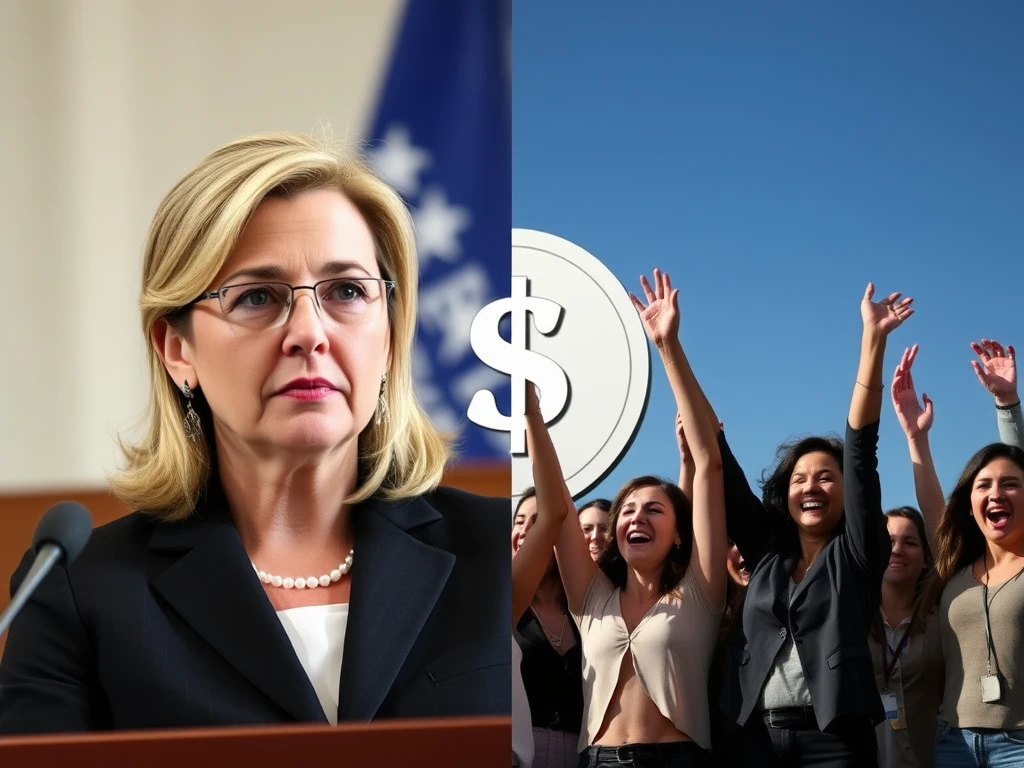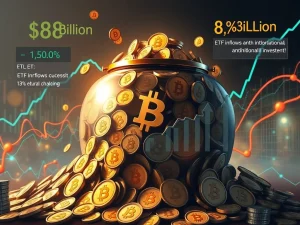Shocking SEC Stablecoin Stance: Critic Crenshaw Exposes ‘Distorted Picture’ of USD Market

The crypto world is buzzing over the latest developments in stablecoin regulation, but not everyone is singing the same tune. While some industry players are welcoming the SEC’s new guidelines with open arms, a prominent voice within the agency itself is raising serious concerns. SEC Commissioner Caroline Crenshaw, known for her critical stance on crypto, has accused the regulator of presenting a ‘distorted picture’ of the USD stablecoin market. Is this a step forward or a misstep in the ongoing saga of crypto regulation? Let’s dive into the details and uncover the controversy.
Crenshaw’s Critique: Are SEC Stablecoin Guidelines Misleading?
Commissioner Crenshaw didn’t mince words in her April 4th statement. She argues that the SEC’s new stance on stablecoins is riddled with ‘legal and factual errors.’ According to Crenshaw, these errors lead to a ‘distorted picture’ of the USD stablecoin market, significantly understating the inherent risks. This is a bold accusation, especially considering many in the crypto space initially viewed the SEC stablecoin guidelines as a positive sign.
Crenshaw, a well-known Crenshaw SEC critic of spot Bitcoin ETFs and broader crypto initiatives, specifically challenged the SEC’s analysis that led to classifying certain stablecoins as ‘non-securities.’ This classification exempts them from certain transaction reporting requirements. But what exactly are her points of contention?
- Questioning the ‘Non-Security’ Label: Crenshaw disputes the SEC’s rationale for deeming some stablecoins as non-securities, suggesting the analysis is flawed and potentially overlooks critical risk factors.
- Challenging Risk Reduction Claims: She pushes back against the SEC’s assertions that issuer actions effectively ‘stabilize price, ensure redeemability, and otherwise reduce risk.’ Crenshaw implies this is an oversimplification of the complex realities of stablecoin operations.
- Retail Access Misrepresentation: The SEC statement mentioned that some USD stablecoins are available to retail purchasers only through intermediaries. Crenshaw argues this is not a minor exception but the norm.
Crenshaw emphasizes that the vast majority – over 90% – of USD stablecoin market circulation reaches retail investors through secondary markets like crypto trading platforms. She believes the SEC’s portrayal downplays this reality, potentially misleading the public about how accessible and widespread these assets truly are.
Crypto Industry’s Optimism: A Step Towards Clarity in Crypto Regulation?
Despite Crenshaw’s sharp critique, a significant portion of the crypto industry is taking a more optimistic stance. Many view the SEC stablecoin guidelines as a much-needed step forward, even if imperfect. Here’s a snapshot of the industry’s reaction:
| Industry Figure | Perspective |
|---|---|
| Ian Ballina (Token Metrics Founder) | Sees it as a ‘clear step in focusing on what really matters in the crypto space.’ |
| Tan Tran (Vemanti CEO) | Wishes the SEC had reached this point three years earlier, highlighting the perceived delay in regulatory clarity. |
| Ian Kane (Midnight Network Head of Partnerships) | Views it as ‘progress for crypto folks trying to play by the rules,’ suggesting a move towards a more workable regulatory framework. |
This positive sentiment underscores the crypto industry’s eagerness for clearer crypto regulation, even if the current guidelines are not universally praised. For many, any movement towards defined rules is better than prolonged uncertainty.
Stablecoin Regulation: Beyond Reserves – What Are the Hidden Risks?
Crenshaw’s concerns extend beyond the immediate classification of stablecoins. She directly challenges the SEC’s apparent reassurance regarding redemption capabilities. The SEC statement suggested that if an issuer’s reserves match or exceed the stablecoin supply, they can handle unlimited redemptions. Crenshaw vehemently disagrees, stating this is ‘grossly inaccurate’.
She argues that focusing solely on reserves provides an incomplete and potentially dangerous picture of a stablecoin issuer’s financial health. Consider these critical points raised by the Crenshaw SEC critic:
- Liabilities Ignored: Reserves only represent assets. They tell nothing about an issuer’s liabilities, which could significantly impact their solvency.
- Proprietary Financial Activities: Stablecoin issuers may engage in various financial activities beyond simply holding reserves. These activities introduce additional layers of risk not reflected in reserve figures.
- Market Downturn Vulnerability: Stablecoins, despite their name, are not risk-free, especially during market downturns. Financial stress can expose vulnerabilities even with seemingly adequate reserves.
Crenshaw’s emphasis on these hidden risks highlights the complexity of stablecoin regulation. Simply matching reserves to supply may not be sufficient to guarantee stability and protect users, especially in volatile market conditions.
Tether’s Audit and the Future of USD Stablecoin Market Trust
The timing of Crenshaw’s statement is particularly interesting as it comes shortly after reports that Tether, a major stablecoin issuer, is engaging with a Big Four accounting firm for a comprehensive audit. This audit aims to verify Tether’s claim that its USDT stablecoin is fully backed 1:1 by reserves. This move by Tether could be seen as a proactive step to build trust and transparency in the USD stablecoin market, especially amidst ongoing regulatory scrutiny.
Furthermore, comments from Tether CEO Paolo Ardoino about a potentially more straightforward audit process under a pro-crypto US President Donald Trump add another layer to the evolving regulatory landscape. It suggests that political shifts could influence the approach and intensity of crypto regulation in the US.
Conclusion: A Distorted Picture or Necessary Scrutiny for Stablecoin Regulation?
Commissioner Crenshaw’s strong words paint a picture of deep disagreement within the SEC regarding stablecoin regulation. While the industry may see the new guidelines as a positive, albeit delayed, step, Crenshaw SEC critic raises valid concerns about potential misrepresentations and underestimated risks within the USD stablecoin market. Her critique serves as a powerful reminder that effective crypto regulation requires more than just surface-level assessments. It demands a thorough understanding of the intricacies and potential vulnerabilities of these complex financial instruments. Whether the SEC’s current approach is truly a ‘distorted picture’ remains to be seen, but Crenshaw’s dissent undoubtedly adds crucial scrutiny to the ongoing debate about how best to regulate the rapidly evolving world of stablecoins.









